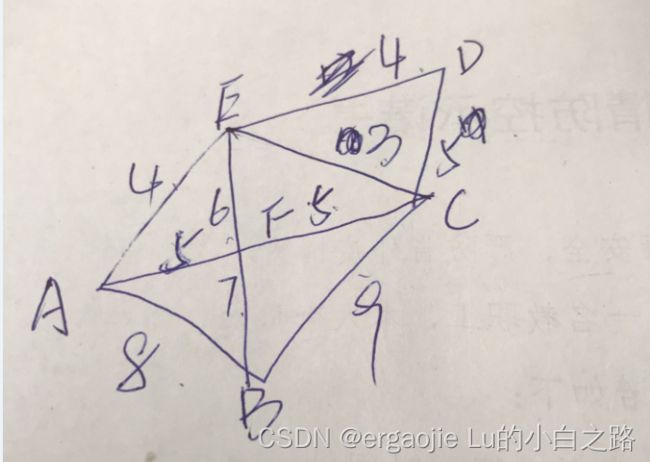Dijkstra (迪杰斯特拉)算法c#实现方法
Dijkstra(迪杰斯特拉)算法是典型的单源最短路径算法,用于计算一个节点到其他所有节点的最短路径。主要特点是以起始点为中心向外层层扩展,直到扩展到终点为止。Dijkstra算法是很有代表性的最短路径算法
算法思想:
设G=(V,E)是一个带权有向图,把图中顶点集合V分成两组,
第一组为已求出最短路径的顶点集合(用S表示,初始时S中只有一个源点,以后每求得一条最短路径 , 就将加入到集合S中,直到全部顶点都加入到S中,算法就结束了),
第二组为其余未确定最短路径的顶点集合(用U表示),按最短路径长度的递增次序依次把第二组的顶点加入S中。在加入的过程中,总保持从源点v到S中各顶点的最短路径长度不大于从源点v到U中任何顶点的最短路径长度。此外,每个顶点对应一个距离,S中的顶点的距离就是从v到此顶点的最短路径长度,U中的顶点的距离,是从v到此顶点只包括S中的顶点为中间顶点的当前最短路径长度。
(1) 初始时,S只包含起点s;U包含除s外的其他顶点,且U中顶点的距离为"起点s到该顶点的距离"[例如,U中顶点v的距离为(s,v)的长度,然后s和v不相邻,则v的距离为∞]。
(2) 从U中选出"距离最短的顶点k",并将顶点k加入到S中;同时,从U中移除顶点k。
(3) 更新U中各个顶点到起点s的距离。之所以更新U中顶点的距离,是由于上一步中确定了k是求出最短路径的顶点,从而可以利用k来更新其它顶点的距离;例如,(s,v)的距离可能大于(s,k)+(k,v)的距离。
(4) 重复步骤(2)和(3),直到遍历完所有顶点。
以这个图为例,求出A——》D的最短距离
代码如下:
using System;
using System.Collections.Generic;
using System.ComponentModel;
using System.Data;
using System.Drawing;
using System.Linq;
using System.Text;
using System.Threading.Tasks;
using System.Windows.Forms;
namespace 验证码
{
public partial class 迪杰斯特拉 : Form
{
public 迪杰斯特拉()
{
InitializeComponent();
}
private void button1_Click(object sender, EventArgs e)
{
List str = new List();//建立List进行存储点
str.Add("A");
str.Add("B");
str.Add("C");
str.Add("D");
str.Add("E");
str.Add("F");//存储
string[] str1 = { "A", "B", "C", "D", "E", "F" };//进行数组存储点(后期进行调用)
int[,] intDis = new int[6, 6];//建立数组存储加权信息
for (int i = 0; i < 6; i++)//全部写入10000(无穷)
{
for (int j = 0; j < 6; j++)
{
intDis[i, j] = 10000;
}
}
intDis[0, 4] = intDis[4, 0] = 4;
intDis[0, 5] = intDis[5, 0] = 5;
intDis[0, 1] = intDis[1, 0] = 8;
intDis[4, 3] = intDis[3, 4] = 4;
intDis[4, 5] = intDis[5, 4] = 6;
intDis[2, 4] = intDis[4, 2] = 3;
intDis[5, 1] = intDis[1, 5] = 7;
intDis[5, 2] = intDis[2, 5] = 5;
intDis[1, 2] = intDis[2, 1] = 9;
intDis[3, 2] = intDis[2, 3] = 5;//对网络加权值进行构建
string[] jihe = new string[6];//路径数组(以A为起点)
jihe[0] = "A";
jihe[1] = "B";
jihe[2] = "C";
jihe[3] = "D";
jihe[4] = "E";
jihe[5] = "F";
List mListptS = new List();//点名S(最短)
List mListptDisS = new List();//点距离(最短)
List mListptU = new List();//点名U(临时存储)
List mListptDisU = new List();//点距离U(临时存储)
mListptS.Add("A");
mListptDisS.Add(0);
mListptU.Add("B");
mListptDisU.Add(8);
mListptU.Add("C");
mListptDisU.Add(10000);
mListptU.Add("D");
mListptDisU.Add(10000);
mListptU.Add("E");
mListptDisU.Add(4);
mListptU.Add("F");
mListptDisU.Add(5);//按B,C,D,E,F进行存储,保证点与距离,str对应
for (int i = 1; i < 6; i++)
{
jihe[i] = "A" +"==>"+ jihe[i];//确定起点为A
}
while (mListptU.Count != 0)//对U点集进行判断
{
int temp = 10000;//无穷距离
int min = 10000;//无穷距离
int suoyin = 0;//索引
for (int i = 0; i < mListptU.Count; i++)
{
if (temp > mListptDisU[i])
{
if (min > mListptDisU[i])//进行判断,选取与A距离最短的点
{
min = mListptDisU[i];
suoyin = i;
}
}
}
mListptS.Add(mListptU[suoyin]);//加入点集
mListptDisS.Add(mListptDisU[suoyin]);//加入距离点集
string ups = mListptU[suoyin];//选择的点,进行后期索引查找
int upsd = 0;//在str中的索引值
for (int i = 0; i < str.Count; i++)
{
if (str[i] == ups)
{
upsd = i;//确定在str中的索引值,保持同步
break;
}
}
int updata = mListptDisU[suoyin];//点到确定点的距离
for (int i = 1; i < mListptDisU.Count; i++)
{
if (intDis[upsd, i] < 10000 || intDis[i, upsd] < 10000)//若不是无穷大进行下一步
{
if (mListptDisU[i - 1] > updata + intDis[i, upsd])//判断新路径是否比原路径短,若短进入下一步
{
mListptDisU[i - 1] = updata + intDis[i, upsd];//对新距离进行存储,注意索引值相对应
jihe[i] = mListptS[0] +"==>"+ str[upsd] + "==>"+str[i];//对路径进行存储
}
}
}
mListptU.Remove(mListptU[suoyin]);//删除点集中的选择点
str.Remove(str[suoyin]);//删除对应的mListptU[]保持后面索引一致
}
string Finally = "D";
for (int i = 1; i < 6; i++)//对A进行忽略(保证索引一致)
{
if (str1[i] == Finally)//选择要计算点的最短路径
{
MessageBox.Show("距离:"+mListptDisU[i - 1].ToString() + "|" +"路径:"+ jihe[i]);//输出
}
}
}
}
}
注:以窗体应用为例
输出的结果为到点的路径与长度。
下次见,拜拜!

